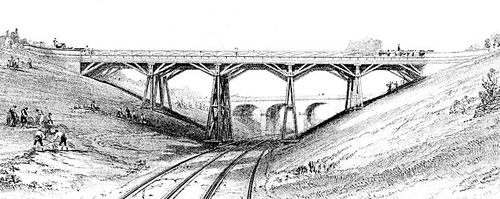Timber Railway Viaducts in Wales
Brunel in South Wales
The spectacular career of
Isambard Kingdom Brunel (1806-59) has been well documented, and he is one of the most widely known figures of Victorian era Britain. He established one of the main national railway networks in the country — the Great Western Railway, linking London to Bristol, and then onwards into Cornwall and to Weymouth, Oxford, Worcester, etc.
Brunel's principal railway lines in England and Wales are listed at right. They include many branch lines and extensions completed after the construction dates shown (i.e., after his death).
Although South Wales was inaccessible directly by rail from southern England because of the width of the Severn Estuary — not bridged or tunnelled until a few decades after Brunel's death — he knew this barrier would be conquered, and had proposed a crossing himself in 1844. He saw the advantages to British industry of connecting the network to Welsh lines such as the
Taff Vale Railway, which he designed. It connected the ironworks of Merthyr Tydfil, and collieries in the Cynon and Rhondda valleys, to Cardiff docks.
Many of Brunel's railways used timber for the construction of viaducts and bridges. The lines in Devon and Cornwall are usually associated with his timber spans. However, it was in South Wales that Brunel made the most extensive use of timber — not only for viaducts, bridges, piers and other infrastructure but also for buildings such as stations and goods sheds.
Brunel's first application of timber to railway works, on the construction of the
Great Western Railway, were limited — a footbridge across
Sonning Cutting (pictured) and a laminated timber viaduct he designed to cross the River Avon at Bath. However, he was already specifying the use of timber for bridges at Taffs Well and Pentyrch on the
Taff Vale Railway, which was constructed at the same time. Timber would come to prominence in his work on the
South Wales Railway, reflecting a need for economy in difficult times.
Brunel's largest timber works were constructed on the South Wales line and the Vale of Neath Railway. They include the longest-surviving completed timber structures, although none now remain. He erected a number of fan-style viaducts on the South Wales Railway, and the Dare Viaduct and Gamlyn Viaduct, on the Amman and Dare branches of the Vale of Neath Railway, are also of the fan type. These two viaducts were the last complete examples in active use and they never passed into British Railways' ownership.
Other principal structures included the
Usk Viaduct at Newport, which burnt down in 1848 and was partially replaced,
Landore Viaduct on the approach to Swansea, which was rebuilt in the 1880s, and
Loughor Viaduct between Swansea and Llanelli. Until its demolition in 2013, the Loughor Viaduct was Brunel's last surviving example of a timber trestle viaduct in Wales — a reconfigured trestle substructure still supported on the original timber piles and carrying mainline rail traffic.
Before looking at the viaducts in more detail, plus timber viaducts by other engineers, let's pause for an outline of the career of Welsh engineer
Rhys William Jones, who worked for Brunel on the survey for the South Wales line, and designed a timber trestle road bridge at Loughor that pre-dates the railway viaduct ......
next >

Brunel's principal railways
IN ENGLAND AND WALES, UK
Great Western Railway : 1835-59
Bristol & Exeter Railway : 1836-46
Bristol & Gloucester Railway : 1840-44
South Devon Railway : 1844-49
South Wales Railway : 1846-58
Gloucester & Dean Forest Railway : 1847-54
Vale of Neath Railway : 1847-56
West Cornwall Railway : 1850-59
Cornwall Railway : 1852-59
Dartmouth & Torbay Railway : 1857-59
West Somerset Railway : 1857-59
Bristol & South Wales Union Railway : 1858-59
The modest fan-style timber bridge across the Sonning Cutting, east of Reading in Berkshire on Brunel's Great Western Railway, pictured in 1862. The railway opened in 1840.
Image: public domain





